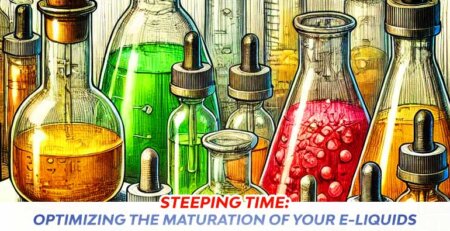Flavoring Your E-liquids: Create Your Perfect Blends
Introduction
The art of DIY e-liquid largely lies in flavoring. Finding the right concentration of flavoring is crucial for achieving a balanced, enjoyable e-liquid that meets your expectations. In this article, we will explore the basics of flavor dosing, provide tips for creating your own recipes, and help you avoid common mistakes. Whether you’re a novice vaper or a DIY expert, this article will assist you in creating harmonious and flavorful blends.
1. Understanding the Basics of Flavor Dosing
1.1. Concentration of Flavors in an E-liquid
- Standard: Most commercial e-liquids contain between 5% and 15% flavoring, depending on the desired strength.
- Customization: In DIY, the dosage can be adjusted based on personal preferences, the type of flavor (tobacco, fruity, dessert, etc.), and the equipment used.
1.2. Factors Influencing Flavor Dosing
- Type of Flavor: Concentrated flavors require a lower dosage, while lighter flavors may need a higher concentration.
- PG/VG Ratio: A high VG (vegetable glycerin) ratio can mute flavor, so it may be necessary to increase the flavor dosage.
- Steeping Time: Some flavors require a longer steeping time to fully develop, especially complex flavors like tobaccos or custards.
2. Calculating the Right Flavor Dose
2.1. The Basics of Calculation
- Basic Calculation: For a 100 ml e-liquid with 10% flavoring, you will need 10 ml of flavoring.
- Formula:Volume of flavor (ml)=(Desired percentage100)×Total volume of e-liquid (ml)\text{Volume of flavor (ml)} = \left( \frac{\text{Desired percentage}}{100} \right) \times \text{Total volume of e-liquid (ml)}Example: For a 50 ml e-liquid with a 12% dosage, you will need:
(12100)×50=6 ml of flavor\left( \frac{12}{100} \right) \times 50 = 6 \text{ ml of flavor}
2.2. Using a DIY Calculator
To simplify calculations, you can use an online DIY calculator. Just enter the total volume of your preparation, the desired percentage of flavor, and the nicotine concentration (if applicable). The calculator will provide you with the exact quantities of each component.
3. Adjusting Dosage According to Flavor Type
3.1. Fruity Flavors
- Recommended Dosage: 8-12% on average.
- Tip: Fruity flavors mix well. Start with a moderate dosage and adjust as needed.Example Recipe:
- 5% strawberry, 4% banana, 2% mint for a fresh fruity cocktail.
3.2. Dessert Flavors (Custards, Creams)
- Recommended Dosage: 10-15%.
- Tip: These flavors require a longer steeping time (2-4 weeks) to develop all their subtleties.Example Recipe:
- 10% vanilla custard, 3% caramel, 2% hazelnut for a creamy recipe.
3.3. Tobacco Flavors
- Recommended Dosage: 5-10%.
- Tip: Less concentrated than other flavors, they pair well with sweet or fruity notes.Example Recipe:
- 7% blonde tobacco, 3% bourbon vanilla, 1% dark chocolate for a complex blend.
4. How to Test and Adjust Your Doses
4.1. Preparing Small Quantities
- Why?: Before making large quantities, test with small bottles (10-20 ml) to refine your recipe.
- Method: Start with a medium flavor dose (e.g., 10%), taste after 24-48 hours, and adjust to your preferences.
4.2. Step-by-Step Method
- Add your flavor in increments of 1%, taste, and adjust.
- Keep detailed notes of each change so you can easily reproduce your ideal recipe.
5. Common Mistakes to Avoid
5.1. Overdosing on Flavors
- Problem: Excess flavor can lead to an unpleasant, chemical, or “muddy” taste.
- Solution: Stick to recommended dosages and prefer to add gradually rather than all at once.
5.2. Neglecting Steeping Time
- Problem: Some recipes require time to develop. Impatience can lead to disappointment.
- Solution: Wait at least 3 to 7 days for fruity recipes, and up to 4 weeks for dessert or tobacco recipes.
5.3. Not Mixing Enough
- Problem: Insufficient mixing can lead to uneven distribution of flavors.
- Solution: Use a magnetic stirrer or shake your bottles vigorously for at least 30 seconds after adding each component.
6. Using Additives to Perfect Your Blends
6.1. Sweetening Additives
- Effect: Enhances sweetness and creaminess of your e-liquids.
- Example: Add 0.5-1% sucralose to sweeten a fruity or dessert blend.
6.2. Flavor Boosters
- Effect: Intensifies the top or base notes of your e-liquid.
- Example: 0.5-1% Koolada for a fresh effect or 1% vanillin to enhance creamy notes.
7. Taste It
On the Taste It website, we offer a wide selection of concentrated flavors for all tastes. Whether you’re looking for fruity, dessert, or tobacco flavors, you’ll find everything you need to create your recipes. Take advantage of our promotions and unleash your creativity by mixing your own DIY e-liquids.
Conclusion
Flavor dosing is a delicate art that requires some experimentation to find the perfect balance. By following our tips, you’ll be able to create e-liquids that meet your expectations, personalizing flavors and sensations to your liking. In our next article, we will explain how to adjust nicotine concentration in your DIY preparations for a vape perfectly suited to your needs.







Leave a Reply